Dorking chickens are among the oldest in the United States.
According to common knowledge, early immigrants transported this bird to the New World because it was the perfect farming chicken.
Dorkings are a fantastic chicken breed that excels as a meat bird and an egg layer. They have a calm demeanor and are great with kids.
To help you decide whether or not Dorking chickens are suitable for your flock, this article covers all you need to know about this ancient breed.
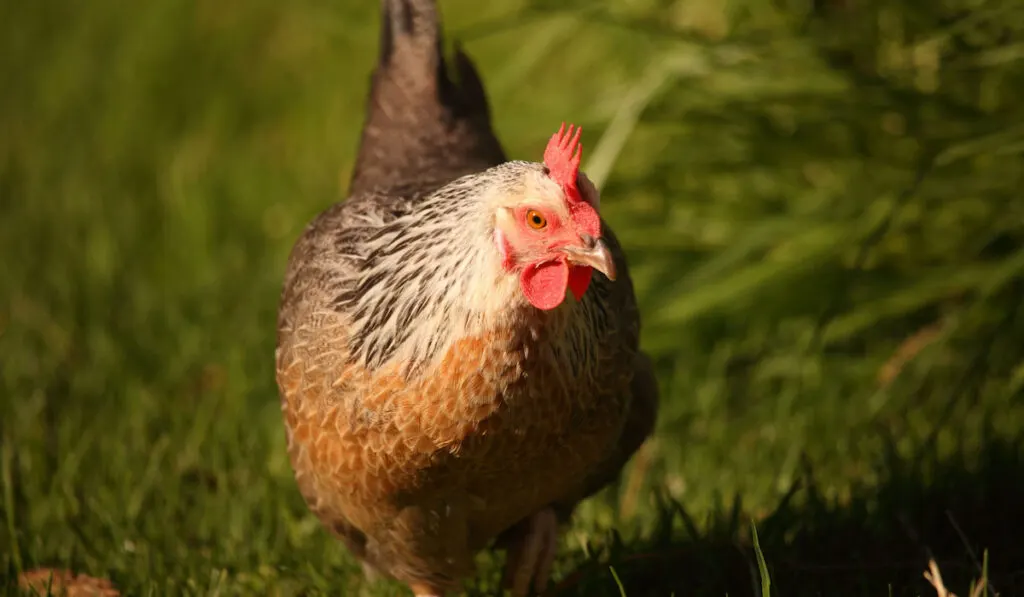
Table of Contents
Dorking Chicken Key Information
| Standard Male Weight: | 10 – 14 lbs. |
| Standard Female Weight: | 8 – 10 lbs. |
| Use: | Dual-purpose breed raised both for meat and for eggs. |
| Egg Size: | Medium to large |
| Egg Production: | 100 per year |
| Lifespan: | 8 years |
| Climate Tolerance: | Mild climates |
| Color: | Silver Gray, White, Red, Cuckoo, Colored |
| Temperament: | Friendly and non-aggressive. |
The History of the Dorking Chicken
The Dorking chicken is a rare breed with a long and interesting history that is at risk of extinction today. Dorking chickens, one of the oldest English breeds, take their name from the town of Dorking.
It is presumed that the Dorking chicken was brought to Britain by Julius Caesar and the Romans. Although, some historians place their arrival after the Norman invasion of 1066.
This fowl is considered one of the first brought to the New World by early settlers.
Before World War I, Dorkings were prized not only for their culinary versatility but also for their beauty as show birds.
As their display qualities on stage developed, their proficiency at the table weakened. Around this time, farmers began using hybrid crosses due to their increased productivity and higher yields.
By the end of World War II, they were no longer widely kept, and only a handful of people were still actively breeding this bird.
When the breed received official recognition for the first time in 1874, the American Poultry Association (APA) accepted three Dorking variants: White, Silver Gray, and Colored.
In the first edition of the American Poultry Association (APA) standards of perfection, in 1874, three varieties of Dorkings were accepted: White, Silver Gray, and Colored.
We can only hope that skilled breeders will make an effort to bring back the Dorking chicken, which is now one of the rarest chicken breeds.
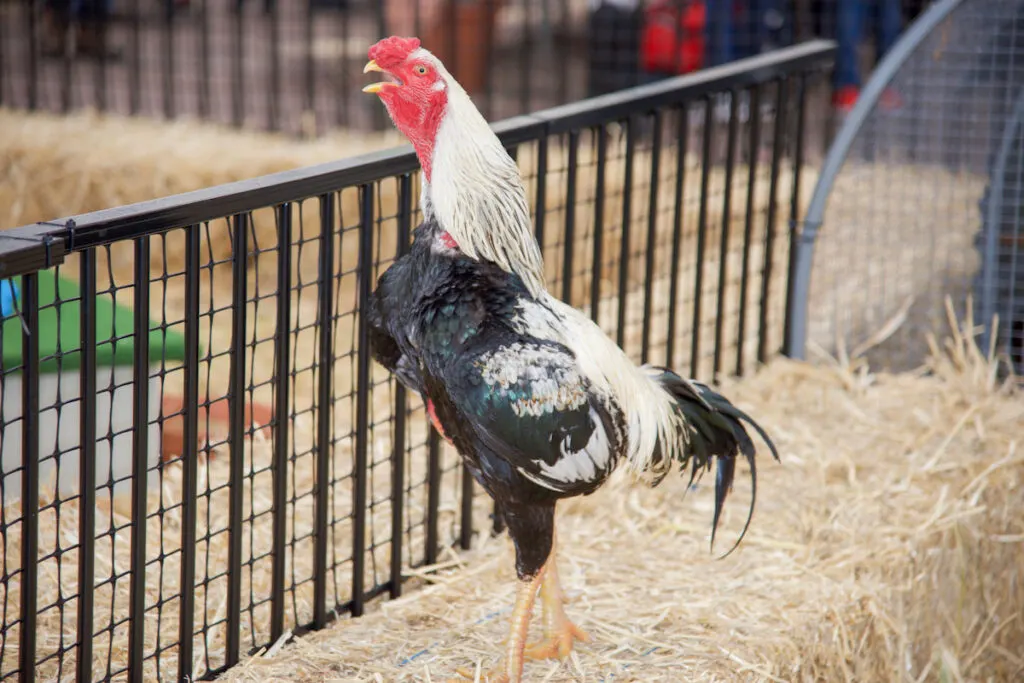
Size of the Dorking Chicken
The Dorking is available in standard and bantam (small) sizes.
- Standard: Cock: 10 – 14 lbs., Hen: 8 – 10 lbs.
- Bantam: Cock: 2.4 –3 lbs., Hen: 2 – 2.5 lbs.
Varieties of the Dorking Chicken
As far as the American Poultry Association or the American Bantam Association is concerned, five officially recognized varieties exist.
- Silver Gray
- White
- Red
- Cuckoo
- Colored
Other than the recognized types, you can find Dorkings in variants like:
- Black
- Dark Birchen Gray
- Light Gray
- Clay
- Crele
- Speckled
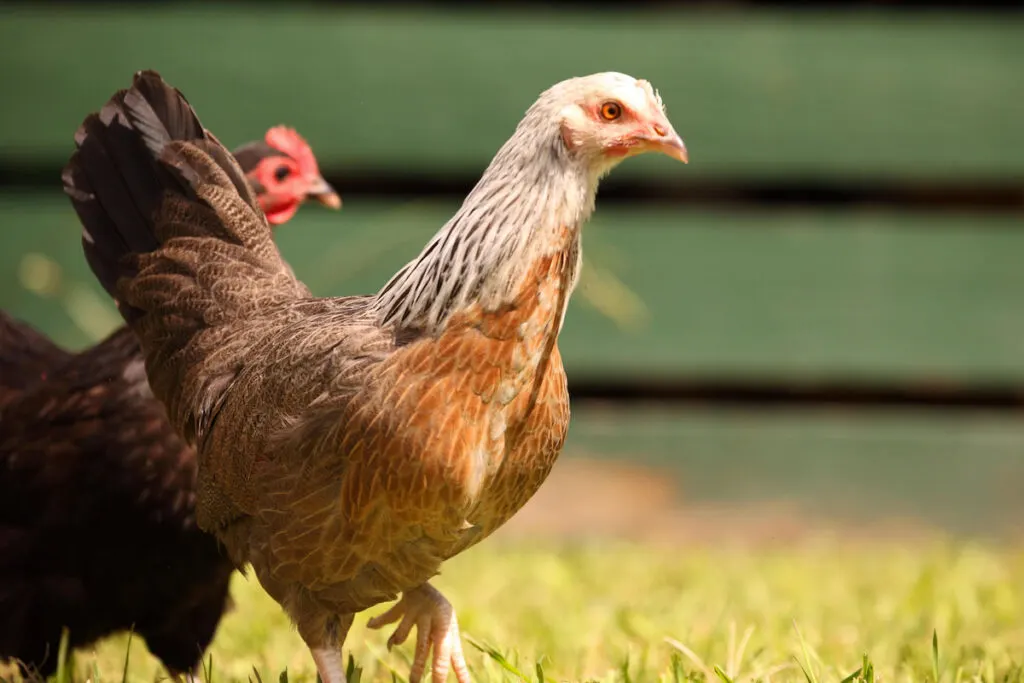
Key Body Features
Compared to other chicken breeds, the Dorking chicken stands out for its large body and relatively short legs. Also, this bird has five toes instead of the usual four like the vast majority of other chicken breeds.
Big wattles, brownish-red bay eyes, red earlobes, and pinkish-white shanks and feet round out the physical characteristics of a Dorking.
Although the breed standards do not yet cover all possible comb and color combinations, most Dorking keepers agree that both the single comb and the rose comb are acceptable features for a Dorking.
A single comb can range in size from large to medium and may appear floppy.
Both roosters and hens have longer feathers on the ends of their tails.
Use
Dorking chickens are a versatile breed that can produce both meat and eggs.
The Dorking was originally developed for its superior meat, but they are also excellent choices for winter laying.
Meat Production
If you’re looking for tasty chicken, Dorkings are a great option. This chicken breed is often considered among the best in terms of flavor.
This high-quality bird has the meat distributed evenly throughout, which results in a product that is extremely soft while remaining lean.
The Dorking also gets praise for having visually appealing and tasty skin.
The skin of many backyard chickens that weren’t raised for the purpose of mass production is typically yellow or gray, which is completely normal.
Some people, however, hold the opinion that chicken skin must be white for it to be safe to eat. This is completely false.
However, if it’s something that worries you, you should know that Dorkings have white skin.
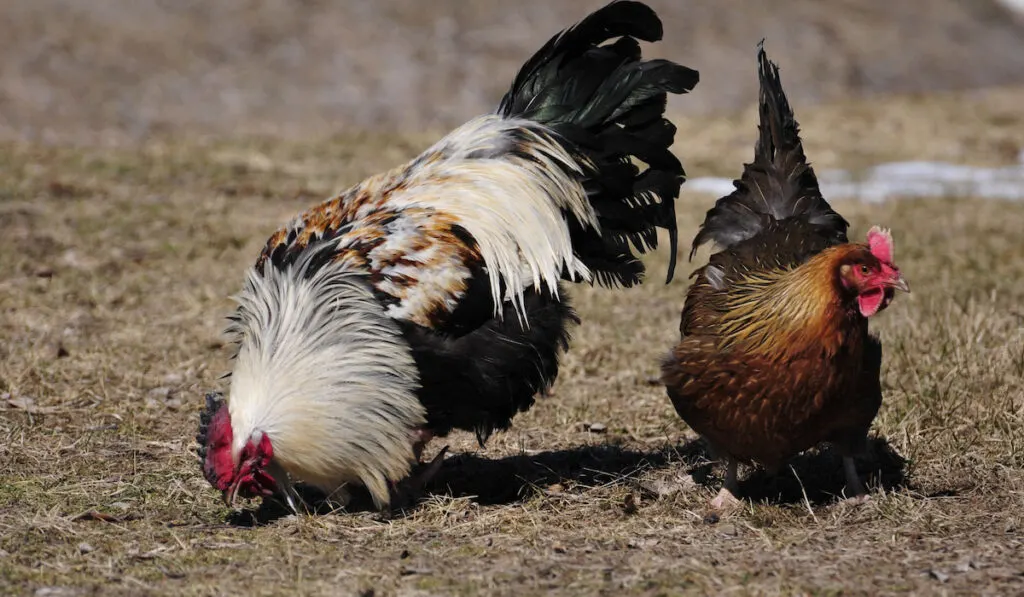
Dorking Chicken Growth
Dorkings used to be a lucrative breed, but that all changed when fast-growing broilers became available. For the patient little farmer, however, the longer maturation time is well worth it.
As opposed to hybrid broiler breeds, Dorking chickens take longer to reach maturity. It takes at least 6–7 months for them to grow to butchering size.
Egg Production
Chickens with a strong reputation for either meat or eggs are rarely used for the other. While most large meat chickens don’t lay many eggs, Dorkings are an exception to this rule.
The Dorking’s egg production is sufficient to compete with that of reputable laying hens of other breeds.
Also, unlike some other chicken breeds, these hens are known for producing a consistent number of eggs throughout the winter.
When not broody, they lay an average of 100 eggs, ranging in size from medium to large, that are white to creamy in color.
They also do an excellent job of caring for their young and sitting on eggs. That way, you can skip the whole incubation process.
Broodiness
In the correct setting, Dorking hens will most likely go broody.
If they do, they are above-average mothers who care for their chicks for a more extended period of time than an average hen.
Providing a number of separate nesting places improves the chances of successful brooding.
In addition, once the hens begin to sit, separating the more dominant breeds is important to maintain peaceful and secure environments.
Lifespan
The average lifespan of a Dorking chicken is between seven and eight years.
Perfect Weather Conditions for Dorking Chickens
Dorking chickens were developed to thrive in mild climates. Unfortunately, Dorking chickens struggle to thrive in tropical climates.
They may be able to withstand some heat, but they will require a protected, shady place to rest as well as enough fresh, cool water to drink.
The enormous combs and wattles that are characteristic of Dorking roosters make them less resistant to the cold than other breeds of roosters.
This is especially the case with the variant with a single comb. The rose comb variety is slightly more cold-resistant.
However, single-comb or rose-comb Dorking hens can withstand sub-zero temperatures for extended periods of time.
The short legs and low body of a Dorking chicken make it more likely that it will become dirty than a chicken of a different breed. If you live in a very rainy region, keep this in mind.
Dorkings might not be the most suitable birds for a muddy environment.
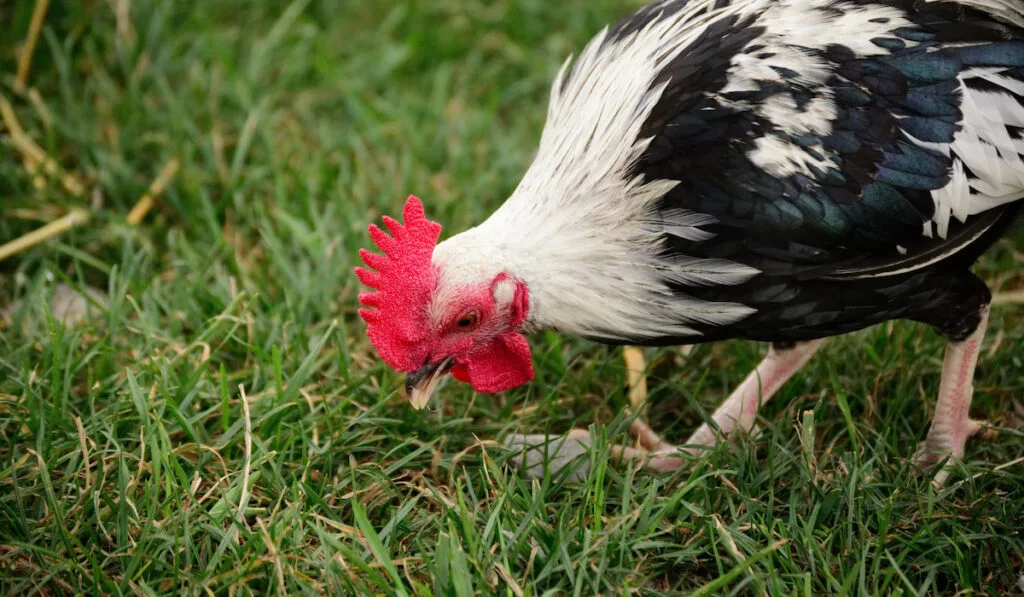
Temperament
The Dorking chicken has a pleasant demeanor and is a skilled forager.
Domestic chicken breeds that stayed close to the house and came when called were highly valued as a dependable source of meat in the past since they were easy to catch and butcher.
Dorking was, therefore, one of the favorites in the past and is a great choice now for homesteaders who prefer to raise meat birds in the traditional manner.
Dorking chickens have gone from being primarily used as a source of food to being beloved pets because of their reputation as one of the friendliest, sweetest breeds around.
It’s not uncommon for a Dorking to follow you around the house or yard while you go about your day. Because of this, they make wonderful backyard foragers, significantly reducing the number of annoying pests such as rats and flies.
Housing Requirements for Dorking Chickens
Dorking chickens can be kept in a confined run or roam freely. However, the former is their favorite way of living.
Because of their large size, Dorking chickens need a large enclosure to prevent them from becoming obese.
For their own well-being and your own peace of mind, you should give them room to run around and explore.
Dorkings are superb foragers and like the freedom of the open range.
Additionally, unlike most other breeds, they are not known for excessive scratching, meaning they are less likely to cause harm to your garden.
Dorking chickens are able to avoid predators with reasonable success. Rather than wandering great distances in search of food, they forage near their nesting areas.
They are also massive birds, and as a result, their size may discourage potential predators, especially the majority of birds of prey.
Also, as a large breed with relatively short legs, Dorkings have special housing needs, such as larger nesting boxes and lower roosting bars.
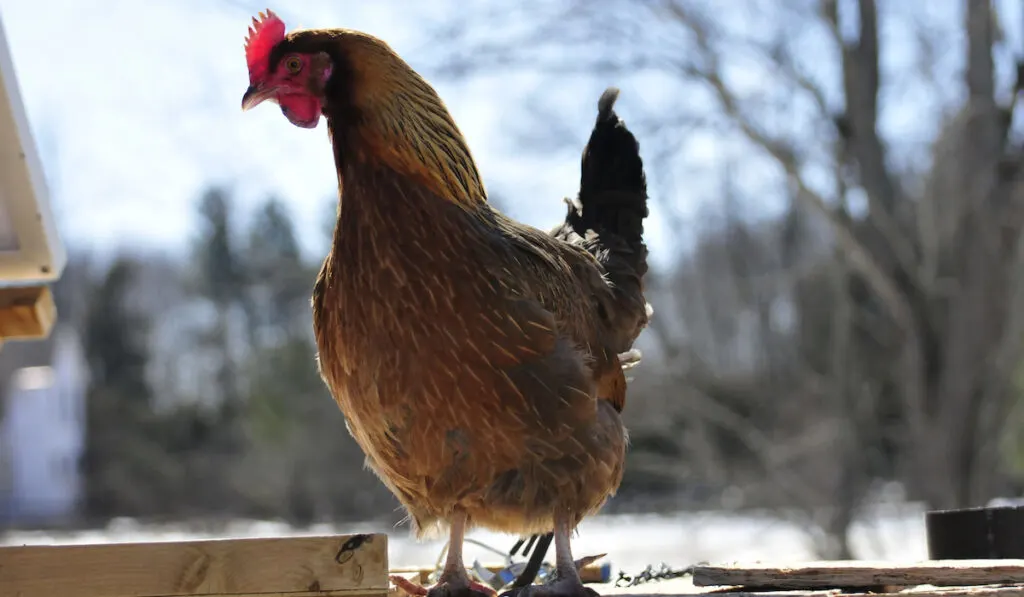
Dorking Chicken Health Problems
Dorking chickens are a large meat breed that can become overweight if not given adequate space to roam.
In addition to this, Dorkings have a significantly increased risk of contracting respiratory illnesses.
And every once in a while, your Dorkings may need you to clip the nail on their unique fifth toe. This is because the toe grows vertically, making it difficult for birds to walk on it, and the nail never naturally wears away.
Final Thoughts
The Dorking chicken breed is the oldest of all the different types of chickens native to the United Kingdom. Unfortunately, these birds are becoming extinct at an alarming rate nowadays.
Dorking chicken is known for its calm demeanor and kind nature and is an excellent forager.
In addition to being an excellent mother, this lovely yardbird is also a delight to have around.
This chicken provides both delicious food and a reliable supply of eggs.
So, if you have been searching for a breed of chicken that will provide your family with meat, eggs, and friendship, then you have found the right one!
Resources
- https://poultrykeeper.com/chicken-breeds/dorking-chickens/
- https://breeds.okstate.edu/poultry/chickens/dorking-chickens.html
- https://www.thefeatherbrain.com/blog/dorking-chickens
- https://www.thehappychickencoop.com/dorking-chicken/
- https://thriftyhomesteader.com/dorking-chickens/
- https://chickenjournal.com/dorking-chicken/?utm_content=cmp-true
